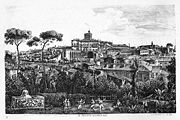
Luigi Rossini
Encyclopedia
Luigi Rossini was an Italian
artist
, best known for his etching
s of ancient Roman
architecture.
Rossini was born in Ravenna
, and studied at the Academy of Bologna
with Antonio Giuseppe Basoli, graduating in 1813 as an architect and artist.
Like his predecessor Giovanni Battista Piranesi
, Rossini focused on extant antique Roman
architecture and excavations in Rome and its environs, and rendered in exquisite detail classical architecture of Rome and its surrounding countryside. In contrast to Piranesi, he made greater use of the bucolic settings in his etchings of Roman ruins. His images of the architectural masterpieces of ancient Rome, including the Pantheon
, the Coliseum, the Appian Way
, the Temple of Peace
, and the Golden House
of Nero
, have greatly influenced architects, artists, writers, and other connoisseurs of Roman culture up to the present day.
His first series of views were published in 1814. He began his Roman antiquities series in 1819, completing 101 large folio plates which were published in Rome in 1823.

Italy
Italy , officially the Italian Republic languages]] under the European Charter for Regional or Minority Languages. In each of these, Italy's official name is as follows:;;;;;;;;), is a unitary parliamentary republic in South-Central Europe. To the north it borders France, Switzerland, Austria and...
artist
Artist
An artist is a person engaged in one or more of any of a broad spectrum of activities related to creating art, practicing the arts and/or demonstrating an art. The common usage in both everyday speech and academic discourse is a practitioner in the visual arts only...
, best known for his etching
Etching
Etching is the process of using strong acid or mordant to cut into the unprotected parts of a metal surface to create a design in intaglio in the metal...
s of ancient Roman
Rome
Rome is the capital of Italy and the country's largest and most populated city and comune, with over 2.7 million residents in . The city is located in the central-western portion of the Italian Peninsula, on the Tiber River within the Lazio region of Italy.Rome's history spans two and a half...
architecture.
Rossini was born in Ravenna
Ravenna
Ravenna is the capital city of the Province of Ravenna in the Emilia-Romagna region of Italy and the second largest comune in Italy by land area, although, at , it is little more than half the size of the largest comune, Rome...
, and studied at the Academy of Bologna
Bologna
Bologna is the capital city of Emilia-Romagna, in the Po Valley of Northern Italy. The city lies between the Po River and the Apennine Mountains, more specifically, between the Reno River and the Savena River. Bologna is a lively and cosmopolitan Italian college city, with spectacular history,...
with Antonio Giuseppe Basoli, graduating in 1813 as an architect and artist.
Like his predecessor Giovanni Battista Piranesi
Giovanni Battista Piranesi
Giovanni Battista Piranesi was an Italian artist famous for his etchings of Rome and of fictitious and atmospheric "prisons" .-His Life:...
, Rossini focused on extant antique Roman
Rome
Rome is the capital of Italy and the country's largest and most populated city and comune, with over 2.7 million residents in . The city is located in the central-western portion of the Italian Peninsula, on the Tiber River within the Lazio region of Italy.Rome's history spans two and a half...
architecture and excavations in Rome and its environs, and rendered in exquisite detail classical architecture of Rome and its surrounding countryside. In contrast to Piranesi, he made greater use of the bucolic settings in his etchings of Roman ruins. His images of the architectural masterpieces of ancient Rome, including the Pantheon
Pantheon, Rome
The Pantheon ,Rarely Pantheum. This appears in Pliny's Natural History in describing this edifice: Agrippae Pantheum decoravit Diogenes Atheniensis; in columnis templi eius Caryatides probantur inter pauca operum, sicut in fastigio posita signa, sed propter altitudinem loci minus celebrata.from ,...
, the Coliseum, the Appian Way
Appian Way
The Appian Way was one of the earliest and strategically most important Roman roads of the ancient republic. It connected Rome to Brindisi, Apulia, in southeast Italy...
, the Temple of Peace
Temple of Peace
Temple of Peace may refer to:*Temple of Peace, Cardiff, a non-religious civic building in the civic centre of Cardiff, Wales*Temple of Peace, Rome, also known as Forum of Vespasian, one of the imperial forums...
, and the Golden House
Domus Aurea
The Domus Aurea was a large landscaped portico villa, designed to take advantage of artificially created landscapes built in the heart of Ancient Rome by the Emperor Nero after the Great Fire of Rome had cleared away the aristocratic dwellings on the slopes of the Palatine...
of Nero
Nero
Nero , was Roman Emperor from 54 to 68, and the last in the Julio-Claudian dynasty. Nero was adopted by his great-uncle Claudius to become his heir and successor, and succeeded to the throne in 54 following Claudius' death....
, have greatly influenced architects, artists, writers, and other connoisseurs of Roman culture up to the present day.
His first series of views were published in 1814. He began his Roman antiquities series in 1819, completing 101 large folio plates which were published in Rome in 1823.


